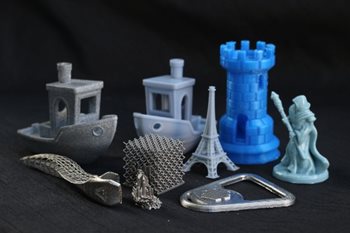By Felicia Campbell

Imagine a world where we used the exact amount of materials needed to build a house or assemble a car, with absolutely no waste. Imagine producing missing parts that have been out of stock for decades or transforming an idea into a physical prototype in mere hours. Those are but a few of the real-world applications that are now possible through the use of additive manufacturing (AM), often referred to as '3D Printing'.
Additive manufacturing is the process of joining layers of materials to create a physical model based on a design created using computer-aided-design (CAD) software or a 3D object scanner.
Conventional manufacturing relies on subtractive processes, like machining, cutting or milling a material until it is transformed into the desired shape. In contrast, additive manufacturing builds objects, depositing material where needed, and there is far less material waste.
Reducing waste is just one of the advantages of this technology. The most exciting for many innovators is that AM allows for the creation of complex designs that never would have been possible using conventional processes. It provides engineers with the ability to design and produce parts that incorporate complex structures and materials without requiring assembly, customize products and produce small quantities at a reasonable price and increase efficiency by reducing lead times and costs.
"I believe that freedom of design is the most exciting aspect of additive manufacturing," said Mark Dewey of Purple Platypus, a Southern California-based AM company. "Whether it be milled, molded, or assembled does not need to be considered; hence designs can be more ergonomic and aesthetically pleasing."
This transformative approach to manufacturing enables the creation of stronger, lighter, and more complex products that can be used across many industries, from healthcare to automotive. It also creates new opportunities for inventors, as a single prototype can be created and tested in a short amount of time.
 "Almost every day, new additive manufacturing applications are reported," notes UCSD Extension Additive Manufacturing instructor Dr. Jurgen Daniel, a principal at Teclination Consulting Services, where he studies emerging technologies with a focus on AM. "It is a rapidly evolving technology area, so it is essential to understand the fundamentals of it if you wish to invest in it, make recommendations or decisions about it or if you plan to use it."
"Almost every day, new additive manufacturing applications are reported," notes UCSD Extension Additive Manufacturing instructor Dr. Jurgen Daniel, a principal at Teclination Consulting Services, where he studies emerging technologies with a focus on AM. "It is a rapidly evolving technology area, so it is essential to understand the fundamentals of it if you wish to invest in it, make recommendations or decisions about it or if you plan to use it."
Solving shortage problems during COVID
During the COVID-19 pandemic, there have been a wide range of equipment and supply shortages due to everything from factory closures to transportation bottlenecks. The most critical of these shortages involved medical and personal protective gear or PPE. 3D printing technology was used to test and produce everything from a ventilator expansion device to face shields, masks, and a hands-free door opener.
Medical Applications
One of the most widespread uses of additive manufacturing is the fabrication of clear dental aligners, like Invisalign, which take advantage of the technology's ability to produce small runs of customized products.
Every clear aligner is different, which would make them very expensive to fabricate using conventional methods that rely on mass production for efficiency and cost savings.
The molds can be printed out using additive manufacturing after the patient's teeth have been 3D scanned, and the clear aligner plastic sheet can be thermoformed over the printed mold.
Beyond that, AM has been used to help surgeons better visualize the body part they are going to work on by creating 3D models, but this is just the beginning. Hip implants, knee implants and other "mechanical" body parts are already being made using additive manufacturing, but the possibility of printing organs is now being explored in the lab.
Transportation Applications
Another advantage of using additive manufacturing is the ability to create small numbers of customized objects to create spare parts for cars, particularly old cars where it is difficult to find replacement parts.
The aerospace industry also has a great interest in additive manufacturing because of the potential for weight savings. Much lighter parts can be fabricated by leveraging a design technology called 'topology optimization.'
Housing and Construction Applications
Several companies are experimenting with ways to use the technology in the housing world, such as Mightybuildings, which print panels for prefabricated houses that are then assembled onsite; ICON in Austin, Texas, who have demonstrated the effective use of quickly printed building structures for the military use, for example, to hide vehicles; and Project Milestone in the Netherlands, who are printing all the housing elements onsite.
 The potential advantages of 3D printing construction include reduced labor, greater safety on job sites, less material waste, the potential to create new shapes and the ability to experiment with new and potentially lower-cost construction materials.
The potential advantages of 3D printing construction include reduced labor, greater safety on job sites, less material waste, the potential to create new shapes and the ability to experiment with new and potentially lower-cost construction materials.
However, before this technology can be used for mass housing production, printed structures must meet local building code requirements. Which means those codes must be updated based on new materials and methods made possible by additive manufacturing.
What's next for Additive Manufacturing?
To fully take advantage of the potential of this emerging technology, the approach to design itself must change, which has led to the development of an entirely new field called generative design. Generative design makes use of software that creates hundreds of designs that fit a particular set of requirements, allowing the inventor to select and modify any number of designs that can be printed as prototypes and then tested.
In the past, design was restricted by the ability to fabricate it. Additive manufacturing eliminates those boundaries and allows engineers and designers to create new innovations limited only by their imaginations.
Still have questions? Leave your question in the comments, or learn more about UC San Diego Extension's Additive Manufacturing certificate program on our website.